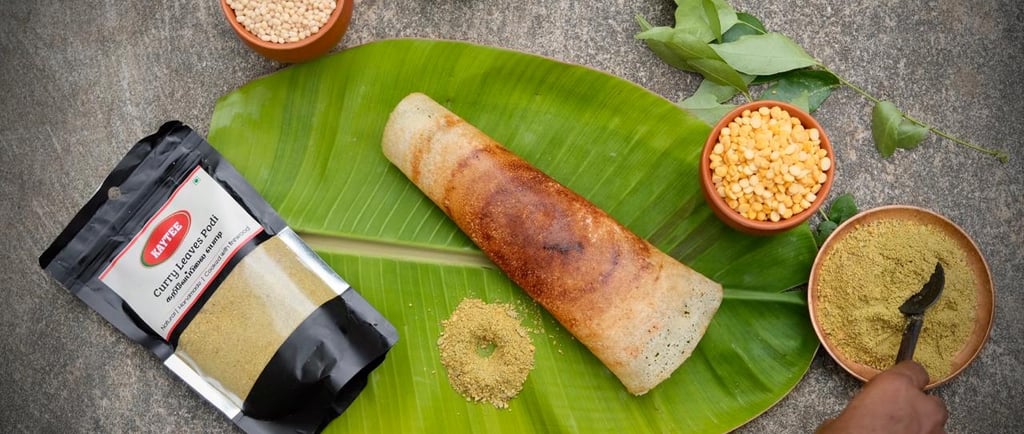The Art of Podis: Essential Spice Blends in South Indian and Kongunadu Cuisine
2/23/20255 min read


Introduction to Podis
Podis, a quintessential component of South Indian cuisine, are spice blends typically ground into fine powders and used to enhance the flavor of various dishes. The word "podi" originates from the Tamil language, meaning powder, and they play a significant role not only in culinary practices but also in cultural traditions. With roots deeply embedded in the history of South India, podis serve as a testament to the region's rich agricultural practices and diverse spices.
Historically, podis can be traced back to ancient times when communities relied on locally sourced ingredients to create flavors representative of their environment. Various spices such as lentils, sesame seeds, and dried red chilies are often roasted and ground to form these aromatic powders. Each podi not only imparts distinct flavors but also serves functional purposes, such as preservation and enhanced nutritional benefits. Traditional methods of preparation emphasize the importance of the fresh roasting of spices, which helps in retaining their natural oils and flavors, furthermore enriching dishes such as rice, curries, and chutneys.
Kongunadu cuisine, which is native to the western region of Tamil Nadu, is an excellent example of how podis are utilized to craft unique and delightful flavors. Characterized by its emphasis on local ingredients and cooking methods, Kongunadu cuisine emphasizes a harmonious blend of tastes, where podis play a pivotal role. The coexistence of podis and Kongunadu cuisine reflects a commitment to authenticity, with each blend telling a story of cultural heritage and culinary innovation. Understanding podis paves the way for a deeper appreciation of both South Indian and Kongunadu culinary practices and sets the foundation for exploring various flavorful blends that continue to delight palate worldwide.
Different Types of Podis and Their Uses
Podis are essential spice blends in South Indian cuisine, particularly in the Kongunadu region, where they add distinctive flavors to a variety of dishes. The diversity of podis mirrors the richness of the culinary traditions in this area. Among the most notable types are Idli podi, Molaga podi, and Paruppu podi, each with its unique ingredients, preparation methods, and culinary applications.
Idli podi, also known as gunpowder, is a versatile blend typically made from a mix of roasted lentils, chili powder, and salt. This powder is often served with idlis, a traditional steamed rice cake, where it complements the soft texture with a spicy kick. To prepare the Idli podi, the lentils and spices are roasted individually, then ground into a coarse powder. Its flavor profile includes a mix of earthy and nutty tones, which elevate the idli experience, making it a favorite among many households.
Molaga podi is another celebrated spice mix that often features a combination of dried red chilies, black gram, and sesame seeds. This podi adds a spicy depth to several dishes, from dosas and rice to vegetables. The preparation involves dry roasting the ingredients until they are fragrant, followed by grinding them into a fine powder. The result is a piquant blend that satisfies the palate and enhances meal enjoyment.
Lastly, Paruppu podi, a lentil-based spice blend, typically comprises roasted split lentils, dried red chilies, and salt. This podi serves as a protein-rich accompaniment to rice and curries, enhancing the overall taste profile of the meal. The preparation is similar to the others, with the ingredients roasted and ground to create a flavorful, aromatic spice mix. Each type of podi is steeped in cultural significance, embodying the essence of everyday meals within the Kongunadu culinary landscape.
Podis in Kongunadu Cuisine
Kongunadu cuisine, a prominent aspect of South Indian culinary heritage, is distinguished by its vibrant use of podis, which are finely ground spice blends essential for flavor development in many traditional dishes. These versatile powder mixes serve not only as seasoning but also as a vital component that enriches the taste and aroma of various meals, manifesting the unique essence of Kongunadu's culinary identity.
One of the quintessential dishes that highlights the use of podis is Kongunadu rice. This flavorful preparation typically incorporates a blend of spice powders, which may include gram flour, dried red chilies, and coriander seeds, complemented with coconut for added richness. The podi used in this dish transforms simple rice into a hearty and satisfying meal, often paired with accompaniments such as pickles and yogurt for contrast.
Vegetable stir-fries, another common preparation in Kongunadu cuisine, also prominently feature different types of podis. For example, a simple stir-fry of seasonal vegetables can be elevated using a combination of spicy and tangy podi, which not only enhances the flavor but also adds nutritional benefits. The specific spices utilized can vary from region to region, allowing for adaptability and creativity while retaining the foundational elements of Kongunadu flavors.
Meat dishes in Kongunadu cooking further exemplify the essential role of podis, as they are often marinated in these spice powders prior to cooking. Meat blends such as chettinad masala or tandoori podi infuse the protein with deep, aromatic flavors while tenderizing it during the cooking process. This technique ensures that every bite is imbued with the warmth and complexity characteristic of the region’s cuisine.
The diversity within Kongunadu cuisine is reflected in the regional adaptations of podi usage, where local ingredients and traditional practices influence the specific spice blends. From the use of sesame seeds in certain varieties to the incorporation of unique herbs, these variations illustrate the rich tapestry of flavors that define Kongunadu cooking, making podis an indispensable element in creating authentic meals.
How to Prepare and Use Podis at Home
Preparing podis at home allows you to experience the authentic flavors of South Indian and Kongunadu cuisine. To begin, sourcing quality ingredients is crucial for creating a rich and aromatic spice blend. Look for fresh spices such as dried red chilies, urad dal, chana dal, fenugreek seeds, and cumin seeds. You can find these at local grocery stores or specialty Indian markets. Choose spices that are vibrant in color and have a strong scent to ensure the best flavor profile.
Once you have gathered your ingredients, the next step involves proper grinding techniques. Begin by dry roasting the spices in a pan over low to medium heat. This process helps in releasing essential oils and enhances the spices' flavor significantly. Stir frequently until the spices are golden brown and fragrant but be cautious not to burn them. After roasting, allow the spices to cool for a few minutes before transferring them to a spice grinder or mortar and pestle. Grind the spices until they form a fine powder, adjusting the consistency based on your preference.
Storage is an important aspect of maintaining the freshness of your homemade podis. Transfer the ground spice blend into an airtight container and store it in a cool, dark place. Podis can last for several months if stored correctly; however, it is best to use them within a month or two for optimal flavor.
Incorporating podis into your everyday cooking can be simple and rewarding. Use them as seasoning for vegetables, rice dishes, or lentils; they can transform a basic meal into something extraordinary. A spoonful of podi can also be mixed with yogurt or ghee for a flavorful dip. Consider trying recipes like podi rice or mixing podis into dosa batter for added depth of flavor. The versatility of podis allows you to experiment and enjoy South Indian cuisine in various forms, enriching your culinary repertoire.
